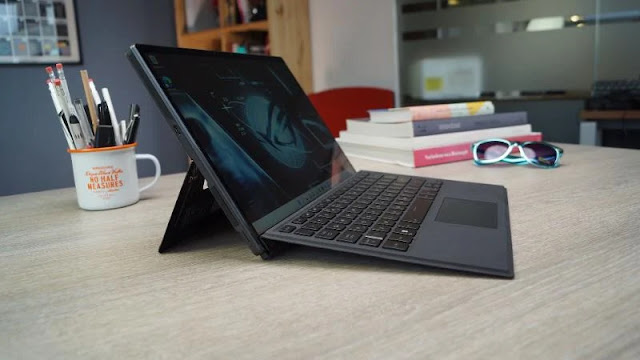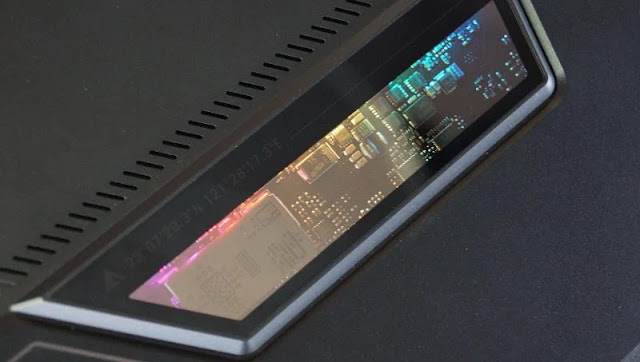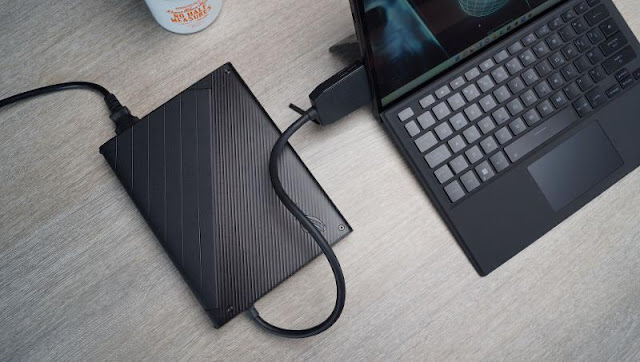The Asus ROG Flow Z13 offers the one thing traditional gaming laptops can't: portability. The question is whether that's enough to justify the premium price tag.
Should I Buy The Asus ROG Flow Z13?
Pros
- Portable design
- XG Mobile GPU dock
- Impressive display
Cons
- Expensive
- Too heavy for standard tablet use
- Sub-par battery life
Our Verdict
Price When Reviewed
- From $1,799.99
While gaming laptops are nothing new, there’s a theme among the top performers: they’re still all bulky and heavy. Asus is one of few companies trying to change that, with experimental devices like 2021’s ROG Flow X13 and now, the tablet-form ROG Flow Z13.
The idea is appealing – it’s a 2-in-1 not dissimilar in design to Microsoft’s Surface Pro line, but with a dedicated GPU and other top-end specs that put it in line with full-on gaming laptops.
There’s also compatibility with the company’s XG Mobile eGPU to spice things up, which has the potential to turn the Flow Z13 into a desktop gaming powerhouse – but it all comes at a very high premium compared to competing gaming laptops.
Has Asus done enough to tempt users from traditional gaming laptops?
Design & Build
- Portable 2-in-1 design
- Lighter than a traditional gaming laptop
- Rear-facing intake vents keep it cool
The Asus ROG Flow Z13 is, simply put, a marvel of engineering. The 2-in-1 tablet barely measures any larger than Microsoft’s Surface Pro 8, yet manages to pack in enough tech to qualify as a fully-fledged gaming laptop with a 12th-gen Intel CPU and an Nvidia GPU at its heart.
For reference, the Alienware M15 R5 measures in at 2.5kg and 23mm thick.
It’s worth noting that while the Flow Z13 is lightweight and portable compared to gaming laptops, it’s much larger and heavier than standard tablets like the 680g iPad Pro, making it hard to use as an actual tablet. You’ll likely be using the Flow Z13 on a table (and likely plugged in) the majority of the time.
The front of the Flow Z13 looks fairly standard with small, but still noticeable bezels, that surround the 13.4in panel but it more than makes up for it on the rear. Flip the 2-in-1 over and you’ll find the signature Asus ROG branding, complete with stylized vents and angular patterns that make it clear it’s a gaming device.
You’ll also find a small 8Mp camera on the rear of the tablet, a bonus compared to standard gaming laptops, accompanied by a 720p camera on the front. These aren’t industry-leading cameras by any means, but they’ll suffice for a quick snap and a video call.
The 2-in-1 design of the Flow Z13 means the intake vents are on the rear rather than the bottom, allowing you to use it on a bed without overheating issues while vents on the top expel heat without you or your hands getting hot. That translates to better gaming performance, but more on that later.
- Great keyboard experience with great travel and backlit keys
- Responsive trackpad, but a little small
- Fewer ports than a traditional gaming laptop
The lightweight keyboard offers a surprisingly high-end typing experience with great travel, a satisfying click and even backlit keys. It’s not quite mechanical keyboard levels, but for a keyboard that thin, it’s great to see. That trend continues with the trackpad that, while a little on the small side compared to some laptops, felt extremely responsive in use.
There are downsides to the 2-in-1 form factor though. For instance, the kickstand design means it won’t stay still when sat on your lap, and there’s a lack of ports compared to the laptop competition too.
The power button, housed on the right, doubles up as a fingerprint reader. It’s not a new concept, available on smartphones, tablets and laptops for some time, but it works as well as you’d expect, reading your fingerprint for authentication as you turn it on. It works the first time most of the time, but you do have to be mindful about finger placement.
Screen & Speakers
- Phenomenal Mini-LED display
- Among the brightest displays around
- Speakers are fine for YouTube videos, but headphones are recommended
At the heart of the ROG Flow Z13 is the 13.4in Mini-LED display with full touchscreen support – to be expected from a tablet, after all. The 16:10 aspect ratio may look a little bit odd for a tablet when rivals are usually much squarer in shape, but the wider aspect ratio does lend itself well to gaming and entertainment.
Importantly, the Flow Z13 is available in two flavours of Mini-LED display; 1080p@120Hz and 4K@60Hz, with the former provided for review. While you may be tempted to go for the 4K model, I’d argue that at just 13.4in, the Full HD resolution is sharp enough for an enjoyable gaming experience, and the buttery-smooth 120Hz refresh rate is crucial for gamers.
Resolution and refresh rate aside, the Flow Z13 display is gorgeous with vibrant colour, plenty of detail and a level of brightness that puts most rivals to shame at an impressive 483nits in tests. The 99% sRGB and 76% AdobeRGB colour gamut may put some colour-correcting creatives off, but it’s great for gaming and of better quality than most gaming laptop rivals.
When it comes to audio, the Flow Z13 sports two side-mounted speakers that are more than enough for watching YouTube videos and casual gameplay, but the lack of bass means most dedicated gamers will opt for a gaming headset.
Asus XG Mobile
- Turns the 2-in-1 into a desktop with multiple displays and more connectivity
- Nvidia GeForce RTX 3080 power
- Can't upgrade the RTX 3080 in future
If you want more gaming prowess than the RTX 3050 Ti from the Flow Z13, you can opt to buy a bundle including Asus’ XG Mobile. It’s Asus’ spin on the eGPU using proprietary tech, offering an upgraded Nvidia RTX 3080 mobile GPU.
The XG Mobile connects to the Flow Z13 via a proprietary port on its left side, locked into place via a small switch on the back of the connector. Asus claims that there are over 67 wires within the cable that allow PCIe 3.0 data transfer speeds of around 63Gbps, almost double the 32Gbps on offer from competing Thunderbolt 4 eGPUs.
I’ll go into more detail about how it performs a little later.
It’s not just an eGPU though; the XG Mobile massively expands connectivity, featuring an HDMI 2.0 port, DisplayPort 1.4, four USB 3.2 Gen 1 ports, an RJ-45 Ethernet jack and an SD card reader for good measure.
The XG Mobile essentially turns the Flow Z13 into a desktop PC setup, allowing for a hybrid experience with full connectivity, desktop-level power and a multi-display setup at home, and a portable 2-in-1 form factor when you’re on the go. It won’t fit everybody’s needs, but it’ll scratch the itch for some.
When that time comes, you’ll have no choice but to get an entirely new XG Mobile – if Asus is making them for the next-gen cards, anyway. For now, it remains one of the best ways to get a desktop-level gaming experience from either the ROG Flow Z13 or last year’s X13 – albeit at a premium.
Specs & Performance
- Full gaming laptop spec with discrete GPU
- Great game performance when plugged in
- XG Mobile can power a desktop-level experience
The Asus ROG Flow Z13 comes in two core configurations: a variant with a powerful Intel Core i9-12900H and an AMD-flavoured variant available sporting the Ryzen 9-5900HS, but this only comes with the Full HD display.
Regardless of the model you opt for, you’ll get the Nvidia RTX 3050 Ti with 4GB of GDDR6 memory, 1TB of SSD storage, 16GB of LPDDR5 RAM and full Windows 11 to play with. For reference, I’ve reviewed the Intel model here.
Most gamers will likely use the Flow Z13 connected to power, so let’s start there. Utilising the 12th-gen Intel CPU and Nvidia’s RTX 3050 Ti, it should come as no surprise that the convertible is capable of powering a decent gaming experience.
While you won’t be able to play the likes of Cyberpunk 2077 at RTX Ultra graphics settings – it hit just 22fps during testing – you can achieve a steady 60fps in most games at a medium preset. The Flow Z13 comfortably surpassed the 60fps mark in Wolfenstein: Youngblood at medium quality, and it’s a similar story in Far Cry: New Dawn, but cranking it up to ultra brought it down to 54fps.
That’s fairly standard for the spec on offer, but if you want more power – be it for gaming or content creation – then you’ll want to hook it up to the XG Mobile eGPU for a more desktop-level experience. Aside from the extra connectivity on offer, the eGPU provides RTX 3080 power that can really give the tablet a boost in performance.
Considering the small dimensions of the convertible and eGPU compared to a standard desktop, it’s impressive, although it’s worth noting that the XG Mobile fans are considerably louder than the almost inaudible fans on the tablet itself when gaming, pumping out plenty of hot air to keep the GPU running smoothly.
While the tablet form factor would suggest great mobile performance, gaming laptops tell us otherwise – and it’s no different with the Flow Z13. In a bid to keep battery consumption down when unplugged from the mains, the hardware doesn’t perform at top speed and there’s a slight dip in performance, even with the ROG Armoury preset set to performance mode.
Though not as dramatic as you might expect, I saw dips across the board in testing, with Far Cry: New Dawn at Ultra dropping from 54- to 41fps. The only game to truly suffer was Cyberpunk 2077, which only managed 12fps at RTX Ultra on battery.
Again, this is commonplace among gaming laptops, but it’s worth pointing out for those that had dreams of playing AAA games on long car journeys.
Our Geekbench 5 benchmarks saw a multi-core score of 11, 685 connected to the XG Mobile, 11,249 on battery power and 8405 on battery, making it a very capable machine for work as well as play.
You can see how the ROG Flow Z13 compares to the gaming laptop competition in all three forms below. For reference, the competition is benchmarked on plugged-in performance.
Performance aside, the rest of the specification is unsurprisingly high-end with connectivity options including the latest Wi-Fi 6E AX211 and Bluetooth 5.2.
Battery Life
- Disappointing battery life when gaming
- Battery isn't much better when working/watching movies
Battery life is another area to consider; while the dream of playing AAA games untethered from the wall is possible, you’ll only get around 60-90 minutes of playtime before the 56Wh battery runs flat. It’s then that you’ll need to reach for the mid-sized 100W USB-C charger.
Thankfully, that’s not indicative of general battery life; less performance-intense tasks like web browsing, watching movies and video calling all fare slightly better on the battery. In our usual video loop test, the Flow Z13 stretched to five hours and 15 minutes.
While that'll be ok for some, it's at the low end of the scale and will likely put off those that want to use the Flow Z13 for work purposes - especially those away from the office.
Price & Availability
The Asus ROG Flow Z13 isn’t the cheapest around, starting at £1,899.99 in the UK and $1,799 in the US – and that’s without the XG Mobile. If you want to bundle the dock with the tablet, the cost goes up to around £2,998/$3,229 – around the same price as a high-end gaming PC with comparable, if not better, specs.
It’s mainly dependent on whether you’ll make use of the hybrid nature of the tablet because if you favour performance over form factor, there are more powerful gaming laptops at a cheaper price point like Asus’ own ROG Strix G15 and others in our best gaming laptop chart.
If you’re interested, the Asus ROG Flow Z13 – in various configurations – are available to pre-order at Amazon and Overclockers in the UK with delivery scheduled for mid-April, and it’s a similar situation for those in the US buying from Newegg.
Verdict
If you like the idea of Microsoft’s Surface Pro 8 but are put off by the integrated graphics on offer, the Asus ROG Flow Z13 may appeal to you.
The impressive internals – including a top-end 12th-gen Core i9 processor and Nvidia’s RTX 3050 Ti – offer a decent gaming experience in a form factor closer to a standard tablet than a traditional gaming laptop, offering a more lightweight, portable design that’s easy to throw into a rucksack.
The 13.4in Mini-LED display is much brighter than rivals, the design is intuitive and the form factor means it's versatile in use too.
However, whether the RTX 3050 Ti performance will be good enough in a few years’ time is yet to be seen, and unlike some gaming laptops, the components can’t be upgraded.
You do have the option to pick up the XG Mobile dock which brings not only RTX 380 power but more USB ports, display connectors and Ethernet connectivity for a more desktop-esque experience, but it’s a sizeable added cost on what is already a premium gaming device.
In all likelihood, the ROG Flow Z13 will be a niche product much like last year’s X13, but it’s refreshing for Asus to try something different to a traditional laptop with advantages not only to size and weight but elements like ventilation, which the Flow Z13 nails.
Specs
- Dimensions: 302 x 204 x 12 mm without keyboard, 17.6 mm thick with keyboard
- Weight: 1.18 kg without keyboard, 1.52 kg with keyboard
- CPU: Intel Core i9-12900H or AMD Ryzen 9-5900HS
- GPU: Intel Iris Xe (integrated), Nvidia GeForce RTX 3050 Ti (4GB DDR6)
- Asus XG Mobile (optional): Nvidia GeForce RTX 3080 (16GB GDDR6)
- Memory: 16GB LPDDR5
- Storage: 1TB M.2 NVMe PCIe 4.0 SSD
- Display: 13.4in Mini-LED display, 1920 x 1200, 16:10 aspect ratio, 120Hz
- Connectivity: Wi-Fi 6E AX211, Bluetooth 5.2
- Ports: Thunderbolt 4, ROG XG Mobile port, USB 2.0 Type-A, 3.5mm headphone jack, microSD card reader
- Camera: 720p webcam, 8Mp rear camera
- Battery: 56Wh
- Charger: 100W USB-C
- OS: Windows 11 Home
















0 comments:
Post a Comment